Recently, just after I viewed the group show Elevated at Gallery VERY in Boston which includes a painting by Candice Smith Corby and sculptures by Sheila Gallagher, Isabel Riley, and Douglas Weathersby, I had the occasion to see a solo exhibition of the works of Ruth Asawa at the Pulitzer Foundation in St. Louis. These two experiences prompted me to think about solo and group exhibitions, but mostly about what a group show accomplishes for participants and viewers. About how, as in Asawa, an iteration becomes transcendent, like listening to Steve Reich’s musical compositions in contrast to how the cluster of artists in Elevated interpret a word becomes wonderfully resonant, more like listening to an Elizabethan contrapuntal choral piece.
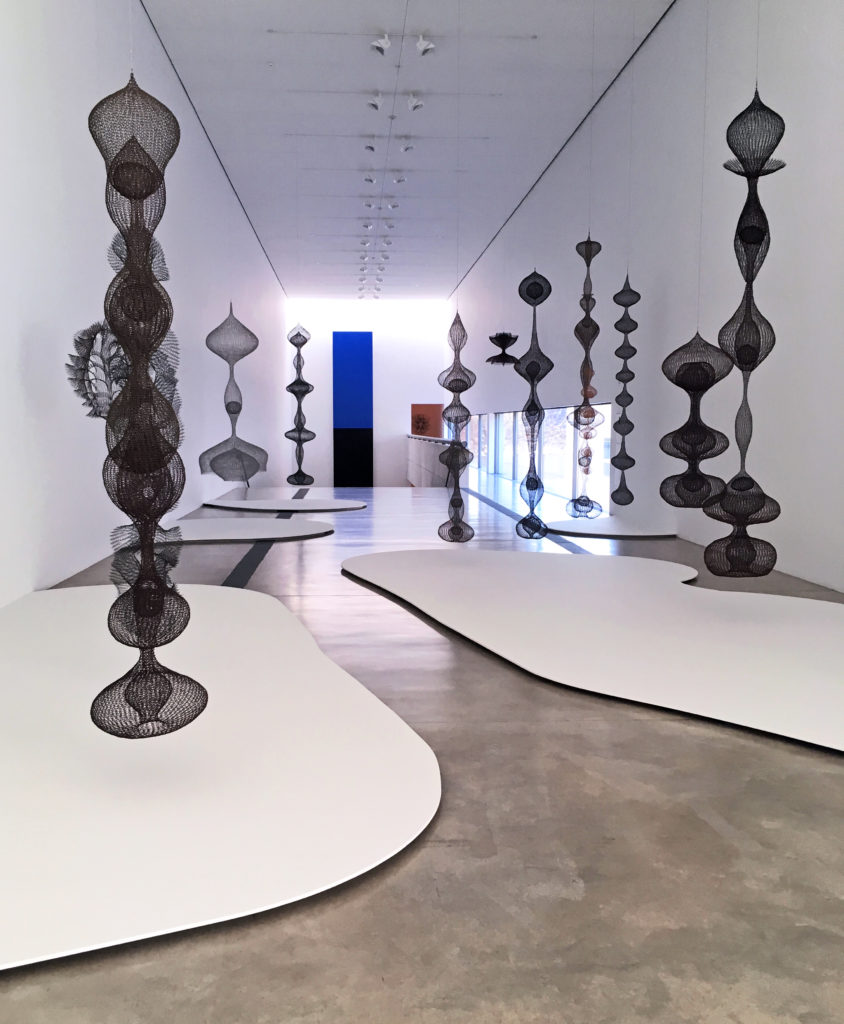
Installation shot of Ruth Asawa: Life's Work on view at the Pulitzer Arts Foundation. Photo: Jill Slosburg-Ackerman.
The remarkable Asawa show allowed for a slow, in-depth examination of the permutations within her form-building. I had the sense of being drawn in and in and in. By contrast, the exhibition Elevated as conjured together by the artist-gallerist John Guthrie sets out an expansive constellation of works that are simultaneously autonomous and uncannily related. Within the gallery, I could sense a community engaged in a palpable dialogue.
In fact, the space at Gallery VERY and the works by this group of artists illustrate the principle of quantum entanglements. Quantum entanglement is a physical phenomenon which occurs when pairs or groups of quantum particles are interacting, in ways such that the quantum state of each particle cannot be described independently from the state of the other(s), even when the particles are separated by a large distance. In a quantum entanglement, the parts of a system—no matter how far away they are from each other in the universe—are intrinsically linked, sharing observable physical properties. Just so, the works of Corby, Gallagher, Riley, and Weathersby are energized by and in dialogue with each other.
John Guthrie, who founded Gallery VERY, uses one half of the space as his studio. Initially, keeping the pragmatics of limited space in mind, John thought of the idea of totems for an exhibition, but ultimately, found the specificity of that term limiting, and eventually a more poetic, broadly spiritual notion of verticality—elevated—became the subject and title for the exhibition. Of note is that some of these artists know each other or their work well. (John and Isabel were studio mates for twenty years. Candice and Douglas were fellow grad students. John and Douglas are close friends.) Each artist spoke of their deep trust in the curator and appreciated the opportunity to contribute to this show. Everyone recognized “the pleasure of the studio” and felt validated after seeing the works of their exhibition-mates.
--
In a conversation with Candice, Douglas, Isabel, Sheila, and John, we spoke of how it is innately human to seek order and therefore to organize objects and ideas, yet we were all astonished by the many echoes in the gallery. Three artists (Candice, Isabel, and Sheila) use gold leaf. The vertical form of the mullein plant in Candice’s painting rhymes with Douglas’ plaster scepters. And as Douglas so importantly says, “everyone either uses or depicts ordinary materials and things.” “This work is all hand” for Sheila, and I agree that “by proximity, one work activates another. The various objects set the ensemble…lots of atoms ricocheting between things.”
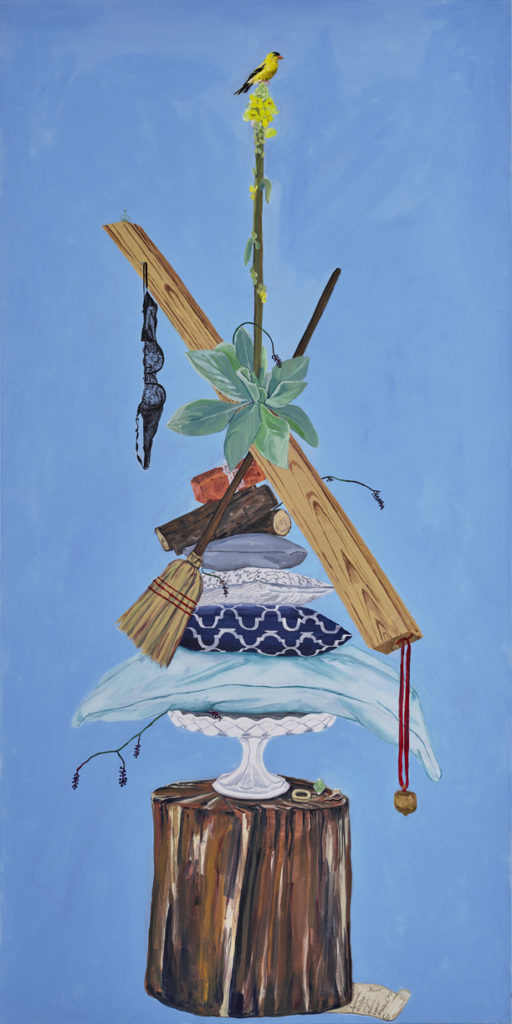
Candice Smith Corby, Sum Total, 2018, acrylic, gouache and gold leaf on canvas. Photo: Stewart Clements
MATERIAL AND FORM.
Candice spoke of the “serendipitous presence of gold leaf in a number of works, yet how, paradoxically, my painting has ‘objectness’ to it, and Sheila’s sculpture is painterly.” For Sheila “the act of adding gold leaf elevates an object—the gritty is made precious. It brings a kind of care and honor to things. Gold purifies them. In Candice’s work, the gold on the outside makes an aura. In Isabel’s, after all the layering, the gold at the top is almost unseen.” Douglas was “imagining the formation of Isabel’s works. There’s a lot of liquid to them, yet they are precise.” For Isabel, “all of this work is about patina and surface.”
DEFINING ELEVATED AND THE SPIRITUAL.
When challenged to make sculpture that would relate to the show’s title, Isabel spoke of “wanting to make work that is more serious, less colorful, of how I was encouraged to think of stacking as a spiritual process and that each work elevates other works. These are psychic orbits.” When Sheila saw Candice’s painting for the first time, she said, “The shell, the bird and the string are the domestic skin of the holy that is in the everyday… And then you turn your head, and the same could be said for Douglas…how much his work looks like shamanistic ritual objects. What you see is what you don’t see that made these gorgeous stalactites. I also started to see them as figural and vulnerable.”
THE MUNDANE AND THE SPIRITUAL.
Candice said, “Something I’ve been thinking about is the mundane, the overlooked, things from everyday life that are elevated by my attention and then how the other works here also elevate them.” Sheila added, “There is a mix of 'ands'—the highest and lowest of things in the world.” For Douglas, “the repetitive process of stacking and dipping common material (paint) became meditative.” “From an unseen time,” said Sheila.
--
A different kind of quantum entanglement, Eric Dolphy’s extraordinary jazz work, “Alone Together” comes to mind. I love the rhythm in the room: that there is only one of Candice’s paintings which allows for leisurely scrutiny; Sheila’s emotional Home Depot cinderblock towers which shelter myriad handmade objects (not made by the artist); Douglas’ dangerous, silky, white tools and weapons; Isabel’s softened, painterly architecture. Elevated is radiant in Gallery VERY, John Guthrie’s hybrid studio-gallery-community.
--
Elevated is on view at Gallery VERY, 59 Wareham Street, Boston, through December 14.
Thanks to D. Heiman, Professor of Physics, Northeastern University, Fellow of the American Physical Society for his guidance in defining quantum entanglements.

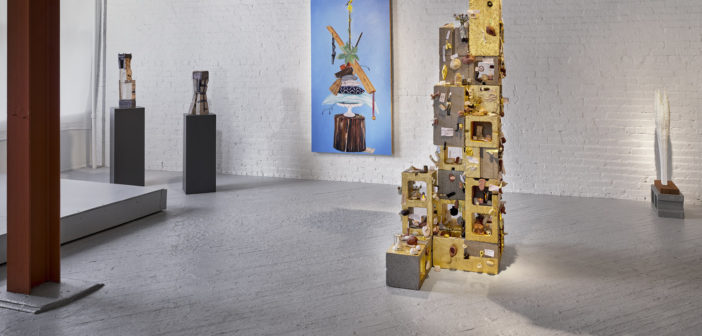
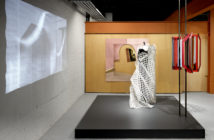
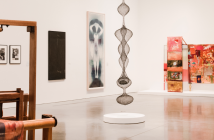
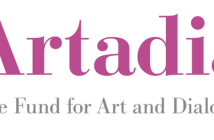
2 Comments
Pingback: Review: Elevated – Isabel Riley
Such a thoughtful and readable and generous review. It adds to the show.